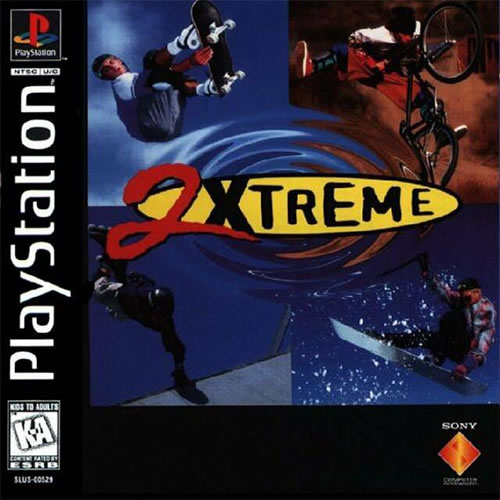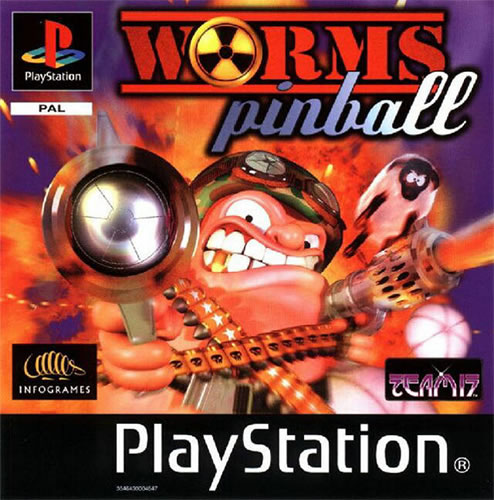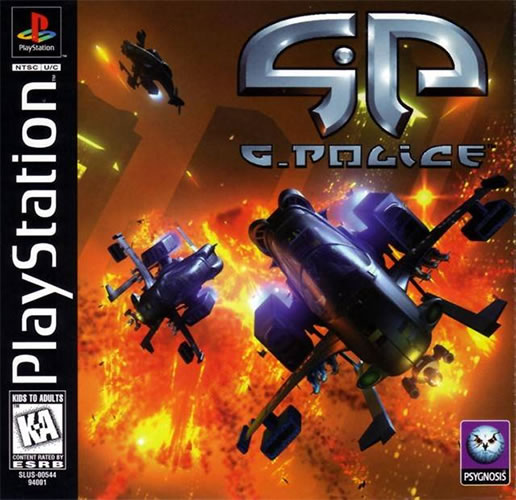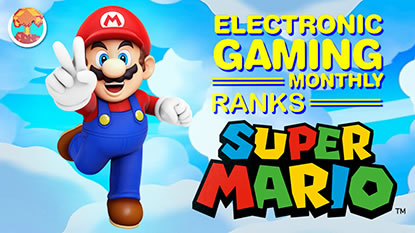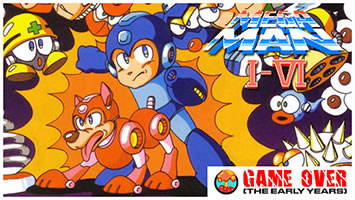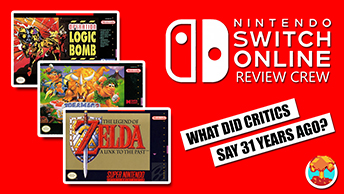- CLASSIC MAGAZINES
- REVIEW CREW
A show recapping what critics thought back
when classic games first came out! - NEXT GENERATION'S BEST & WORST
From the worst 1-star reviews to the best
5-stars can offer, this is Next Generation! - NINTENDO POWER (ARCHIVE)
Experience a variety of shows looking at the
often baffling history of Nintendo Power! - MAGAZINE RETROSPECTIVE
We're looking at the absolutely true history of
some of the most iconic game magazines ever! - SUPER PLAY'S TOP 600
The longest and most ambitious Super NES
countdown on the internet! - THEY SAID WHAT?
Debunking predictions and gossip found
in classic video game magazines! - NEXT GENERATION UNCOVERED
Cyril is back in this spin-off series, featuring the
cover critic review the art of Next Generation! - HARDCORE GAMER MAGAZING (PDF ISSUES)
Download all 36 issues of Hardcore Gamer
Magazine and relive the fun in PDF form!
- REVIEW CREW
- ELECTRONIC GAMING MONTHLY
- ELECTRONIC GAMING MONTHLY RANKS
From Mario to Sonic to Street Fighter, EGM
ranks classic game franchises and consoles! - ELECTRONIC GAMING MONTHLY BEST & WORST
Counting down EGM’s best and worst reviews
going year by year, from 1989 – 2009! - ELECTRONIC GAMING BEST & WORST AWARDS
11-part video series chronicling the ups and
downs of EGM’s Best & Worst Awards!
- ELECTRONIC GAMING MONTHLY RANKS
- GAME HISTORY
- GAME OVER: STORY BREAKDOWNS
Long-running series breaking down game
stories and analyzing their endings! - A BRIEF HISTORY OF GAMING w/ [NAME HERE]
Real history presented in a fun and pithy
format from a variety of game historians! - THE BLACK SHEEP
A series looking back at the black sheep
entries in popular game franchises! - INSTANT EXPERT
Everything you could possibly want to know
about a wide variety of gaming topics! - FREEZE FRAME
When something familiar happens in the games
industry, we're there to take a picture! - I'VE GOT YOUR NUMBER
Learn real video game history through a series
of number-themed episodes, starting at zero! - GREAT MOMENTS IN BAD ACTING
A joyous celebration of some of gaming's
absolute worst voice acting!
- GAME OVER: STORY BREAKDOWNS
- POPULAR SHOWS
- DG NEWS w/ LORNE RISELEY
Newsman Lorne Riseley hosts a regular
series looking at the hottest gaming news! - REVIEW REWIND
Cyril replays a game he reviewed 10+ years
ago to see if he got it right or wrong! - ON-RUNNING FEUDS
Defunct Games' longest-running show, with
editorials, observations and other fun oddities! - DEFUNCT GAMES QUIZ (ARCHIVE)
From online quizzes to game shows, we're
putting your video game knowledge to the test!- QUIZ: ONLINE PASS
Take a weekly quiz to see how well you know
the news and current gaming events! - QUIZ: KNOW THE GAME
One-on-one quiz show where contestants
find out if they actually know classic games! - QUIZ: THE LEADERBOARD
Can you guess the game based on the classic
review? Find out with The Leaderboard!
- QUIZ: ONLINE PASS
- DEFUNCT GAMES VS.
Cyril and the Defunct Games staff isn't afraid
to choose their favorite games and more! - CYRIL READS WORLDS OF POWER
Defunct Games recreates classic game
novelizations through the audio book format!
- DG NEWS w/ LORNE RISELEY
- COMEDY
- GAME EXPECTANCY
How long will your favorite hero live? We crunch
the numbers in this series about dying! - VIDEO GAME ADVICE
Famous game characters answer real personal
advice questions with a humorous slant! - FAKE GAMES: GUERILLA SCRAPBOOK
A long-running series about fake games and
the people who love them (covers included)! - WORST GAME EVER
A contest that attempts to create the worst
video game ever made, complete with covers! - LEVEL 1 STORIES
Literature based on the first stages of some
of your favorite classic video games! - THE COVER CRITIC
One of Defunct Games' earliest shows, Cover
Critic digs up some of the worst box art ever! - COMMERCIAL BREAK
Take a trip through some of the best and
worst video game advertisements of all time! - COMIC BOOK MODS
You've never seen comics like this before.
A curious mix of rewritten video game comics!
- GAME EXPECTANCY
- SERIES ARCHIVE
- NINTENDO SWITCH ONLINE ARCHIVE
A regularly-updated list of every Nintendo
Switch Online release, plus links to review! - PLAYSTATION PLUS CLASSIC ARCHIVE
A comprehensive list of every PlayStation
Plus classic release, including links! - RETRO-BIT PUBLISHING ARCHIVE
A regularly-updated list of every Retro-Bit
game released! - REVIEW MARATHONS w/ ADAM WALLACE
Join critic Adam Wallace as he takes us on a
classic review marathon with different themes!- DEFUNCT GAMES GOLF CLUB
Adam Wallace takes to the links to slice his way
through 72 classic golf game reviews! - 007 IN PIXELS
Adam Wallace takes on the world's greatest spy
as he reviews 15 weeks of James Bond games! - A SALUTE TO VAMPIRES
Adam Wallace is sinking his teeth into a series
covering Castlevania, BloodRayne and more! - CAPCOM'S CURSE
Adam Wallace is celebrating 13 days of Halloween
with a line-up of Capcom's scariest games! - THE FALL OF SUPERMAN
Adam Wallace is a man of steel for playing
some of the absolute worst Superman games! - THE 31 GAMES OF HALLOWEEN
Adam Wallace spends every day of October afraid
as he reviews some of the scariest games ever! - 12 WEEKS OF STAR TREK
Adam Wallace boldly goes where no critic has
gone before in this Star Trek marathon!
- DEFUNCT GAMES GOLF CLUB
- DAYS OF CHRISTMAS (ARCHIVE)
Annual holiday series with themed-episodes
that date all the way back to 2001!- 2015: 30 Ridiculous Retro Rumors
- 2014: 29 Magazines of Christmas
- 2013: 29 Questionable Power-Ups of Christmas
- 2012: 34 Theme Songs of Christmas
- 2011: 32 Game Endings of Christmas
- 2010: 31 Bonus Levels of Christmas
- 2009: 30 Genres of Christmas
- 2008: 29 Controls of Christmas
- 2007: 34 Cliches of Christmas
- 2006: 33 Consoles of Christmas
- 2005: 32 Articles of Christmas
- 2004: 31 Websites of Christmas
- 2003: 29 Issues of Christmas
- 2002: 28 Years of Christmas
- 2001: 33 Days of Christmas
- NINTENDO SWITCH ONLINE ARCHIVE
- REVIEW ARCHIVE
- FULL ARCHIVE
PlayStation Plus: 1990s Critics Review G-Police, 2Xtreme & Worms Pinball
It's time for another PlayStation Plus update, and you know what that means – it's time for another Worms game. That's right, a quarter-century after it was canceled in the United States, we're finally getting Worms Pinball. We're also getting G-Police and 2Xtreme. That's exciting news, but are any of these games actually worth playing? To answer that question, I decided to flip through the pages of Electronic Gaming Monthly, Game Fan, Computer & Video Games and more classic magazines to see what the critics said back when these games first came out. Put on your helmet and knee pads, because we're about to see if you're 2Xtreme for this episode of PlayStation Plus Review Crew!
In the months leading up to the PlayStation's launch, a lot gamers and critics had major concerns that Sony's first-party support wasn't going to be able to compete with juggernaut companies like Nintendo and Sega. This ultimately proved to be false, thanks to a number of strategic acquisitions by the company, but I have to imagine that 2Xtreme is the kind of game everybody was concerned would permeate through the PlayStation's entire library. Released just one year after the system's launch, this sequel is just as limp and half-assed as you remember. Compared to Tony Hawk's Pro Skater and other similar gams that would come just a few years later, this extreme sports game feels like it's still clinging to the last generation and not embracing what could be done with the PlayStation's hardware. Perhaps that's why barely anybody remembers or talks about Sony's Xtreme series, the speedbump you hit while looking for the newest wipEout game.
Needless to say, most of the critics were not impressed with 2Xtreme. I say most because there were a couple outliers, with one of them being Todd Mowatt from Electronic Gaming Monthly. Giving it an 8 out of 10, he concludes that “the PlayStation's top-selling game worldwide has gotten even better. If you were a fan of the first title, you will enjoy this one. The challenges are totally different with more tracks and events added. If you didn't like the first game, then you will be on the same side of the fence as my pal on the other side of the page. The game does have a lot to offer and I had a blast.” As mentioned in the review, Todd's colleague, Joe Rybicki, was not as impressed with 2Xtreme. “This is one of the most unexciting games I've seen on the PlayStation. I wasn't a fan of the first one, and the second one is not an improvement. You think that the designers at Sony would really exploit the abilities of the PlayStation. Instead, the graphics are blocky, the animations jerky and the courses uninspired.” EGM gave 2Xtreme an average score of 6.5 out of 10.
For what it's worth, the other outlier was GamePro, who gave the game a shockingly high score of 4.5 out of 5. They genuinely saw something good with the game, calling it “worthy of its TV heritage.” “Plenty of high-speed action and a tough CPU competitor will keep gamers coming back for more. The biggest appeal is the split-screen, two-player mode for face-to-face action.” “No matter what, you're assured lightning-fast entertaining Xtreme action. Go for it!”
But not so fast, said literally every other critic working in 1996. This included Ultra Game Players, who gave the game a cautionary score of 5.9 out of 10. Believe it or not, that's considered a high-score compared to Next Generation, who went with a lousy 2 out of 5. That's the exact same score you saw over at Computer & Video Games, who put it this way: “The first one had some cool ideas, good graphics for the time (last year!) and a good sense of humour. Unfortunately, 2Xtreme doesn't do anything we'd hoped. The four events are still identical – with the only new addition being trick points, and those aren't much fun at all. This is just another of ‘those' games which, while not completely terrible, has nothing to make it worth buying. The handling which lets you go round tight corners without steering, and the collision detection which leaves you stuck behind pillars just get annoying, plus the lack of original features means that 2Xtreme isn't worth more than a night's rental.”
Honestly, looking back on it all these years later, I'm not even sure it's worth that. Only play this game if you already have nostalgia for 2Xtreme, but even then, I say approach with caution.
When Sony put out the call for third-parties to support PlayStation Plus with PS1 classics, Team 17 picked up. In case you haven't been paying attention, Worms Pinball marks the fourth Worms game released on the service since its release, more than any other series (even Star Wars). What's cool about this particular game is that it was never released in America, making this one of the few PS1 games to have its U.S. debut come in the form of PlayStation Plus. That fact alone makes this an interesting title worth checking out, but let's go ahead and see what the critics said at the time.
Because the game never came to America, there aren't a lot of reviews for Worms Pinball. In fact, I basically only found two. The first was the Official UK PlayStation Magazine, which gave it a 6 out of 10 in their 55th issue. The other was Game Fan, who reviewed the very similar Dreamcast port. ECM gave it a lame 39%, summing it up this way: “I love pinball; I love Worms; I do not love Worms Pinball. Allow me to explain – If you're going to make a pinball game on a console system, make sure that it does things you simply cannot do in a real pinball machine. Sadly, Team 17 seems to have ignored that cardinal rule and at their own peril. Like sports games, if I want to play the real thing, I'll go do it in an arcade, not via a hackjob console pin.” Fury liked it a bit more, giving it a 61%, though he starts out weirdly aggressive against Team 17's most popular franchise: “Unlike most of the Game Fan staff, Worms played no part in my life ... and it never will! And guess what? Neither will Worms Pinball. The problem here is that in order for a home console pinball game to be good, it has to be crazy, and Worms Pinball is the polar opposite of that.”
It's probably worth mentioning that Worms Pinball was also part of a more readily available Team 17 game called Addiction Pinball, which did come to America. While Hyper gave the game a score of 74%, it's actually the Next Generation review I want to focus on. Given how Game Fan's main problem was that Team 17's pinball game wasn't over-the-top enough, I thought this might be a good counterpoint: “The best part of the game is its attention to realism. The ball looks and moves as it would on an actual pinball table – better than the motion of any other ball in any other pinball game. The reflection on the ball, ramps, and flippers is fantastic as well, and the amber screen located at the top of the table, showing off missions, scores and bonuses, is also nicely done. It looks just like the screen on your local arcade's pinball machine, yet it fades into the table just enough so as not to distract. Simply, Addictive Pinball is the smoothest-playing and best-looking pinball game we've seen.”
I suggest giving Worms Pinball a play to see if you prefer its dedication to realism or would have preferred it be more over-the-top.
When it came to the 32-bit era, one of the earliest breakout companies was the Liverpool-based developer Psygnosis. They played a vital role in the early days of the PlayStation, pushing the boundaries with games like Destruction Derby, Colony Wars and, most importantly, the wipEout series. G-Police took their expertise in world-building and upped the stakes in a story-driven action game set in a futuristic city full of crime. Although limited by what the 32-bit hardware was capable of, G-Police is the kind of big, ambitious showpiece you can't help but root for. Simply put, there was nothing else like it on the PlayStation, and you saw a lot of that excitement in the reviews.
When it came to the critics, pretty much everybody was impressed with what Psygnosis was able to do on the PlayStation. Over at Electronic Gaming Monthly, Dan gave the game an 8 out of 10, praising the people behind the game: “With G-Police, Psygnosis reminds everyone why they are such a hip publisher. This stylish game builds a realistic and immersive world, via cinemas and story line, sights and sounds. The control left a little to be desired. Analog is too sensitive, digital is too clunky. Poor control + speedy gameplay + lots of buildings = a disaster. But it's no big deal, I still recommend it highly.” Crispin seemed to like the game even more than Dan, comparing it to a cult favorite: “G-Police has the most incredible cityscapes ever seen in a game. There's just something too cool about chasing bogies between skyscrapers and above traffic-jammed streets. No game since Snatcher has created such a Blade Runner-esque atmosphere.” EGM gave G-Police an average score of 8.4 out of 10.
This is pretty much in line with where the rest of the critics were at the time. For example, you saw Game Fan give G-Police the exact same average of 84%, and GamePro went a tad lower with a score of 4 out of 5. That's the exact same score we see over at Computer & Video Games, as well as PSM. They argued that “the control takes time to master but works acceptably. You are given complete freedom to fly where you want within the large domed cities, which unfortunately leads to the game's only real drawback. The pop-in is dramatic and affects gameplay, as things fade in and out of the black background nearby. You can adjust this somewhat by decreasing or increasing the game's speed. Doing so increases or decreases the viewing distance and angle, but never to the point of clarity. When all added up, G-Police really draws you in, making you feel like you're part of the game.”
That's the basement when it comes to scores, but there are a few that are much higher than that. Ultra Game Players went as high as an 85%, also acknowledging some of the technical issues. And then there's the Official U.S. PlayStation Magazine, which gave it a high score of 4.5 out of 5. They raved about the detailed environments, great control and detailed, well-fleshed out story, though ended their review with some gripes: “The somewhat jerky framerate and extremely noticeable draw-in can be adjusted from the comprehensive options screen. And I did notice a strange popping sound in the speakers during radio communication, which got a bit annoying. But overall, G-Police is a unique, challenging and engrossing title that no sci-fi or flight sim fan should miss.”
This is one of those great little games that desperately needs a remake. The game was simply too ambitious for the PlayStation's hardware, and these days a developer could really execute on the game's potential. Give it a play on PS Plus and you'll see what I mean.
| Publication | Scores |
|---|---|
| GamePro | 4.5/5 |
| Electronic Gaming Monthly | 6.5/10 |
| Ultra Game Players | 5.9/10 |
| Computer & Video Games | 2/5 |
| Next Generation | 2/5 |
| AVERAGE SCORE | 59% |
Needless to say, most of the critics were not impressed with 2Xtreme. I say most because there were a couple outliers, with one of them being Todd Mowatt from Electronic Gaming Monthly. Giving it an 8 out of 10, he concludes that “the PlayStation's top-selling game worldwide has gotten even better. If you were a fan of the first title, you will enjoy this one. The challenges are totally different with more tracks and events added. If you didn't like the first game, then you will be on the same side of the fence as my pal on the other side of the page. The game does have a lot to offer and I had a blast.” As mentioned in the review, Todd's colleague, Joe Rybicki, was not as impressed with 2Xtreme. “This is one of the most unexciting games I've seen on the PlayStation. I wasn't a fan of the first one, and the second one is not an improvement. You think that the designers at Sony would really exploit the abilities of the PlayStation. Instead, the graphics are blocky, the animations jerky and the courses uninspired.” EGM gave 2Xtreme an average score of 6.5 out of 10.
For what it's worth, the other outlier was GamePro, who gave the game a shockingly high score of 4.5 out of 5. They genuinely saw something good with the game, calling it “worthy of its TV heritage.” “Plenty of high-speed action and a tough CPU competitor will keep gamers coming back for more. The biggest appeal is the split-screen, two-player mode for face-to-face action.” “No matter what, you're assured lightning-fast entertaining Xtreme action. Go for it!”
But not so fast, said literally every other critic working in 1996. This included Ultra Game Players, who gave the game a cautionary score of 5.9 out of 10. Believe it or not, that's considered a high-score compared to Next Generation, who went with a lousy 2 out of 5. That's the exact same score you saw over at Computer & Video Games, who put it this way: “The first one had some cool ideas, good graphics for the time (last year!) and a good sense of humour. Unfortunately, 2Xtreme doesn't do anything we'd hoped. The four events are still identical – with the only new addition being trick points, and those aren't much fun at all. This is just another of ‘those' games which, while not completely terrible, has nothing to make it worth buying. The handling which lets you go round tight corners without steering, and the collision detection which leaves you stuck behind pillars just get annoying, plus the lack of original features means that 2Xtreme isn't worth more than a night's rental.”
Honestly, looking back on it all these years later, I'm not even sure it's worth that. Only play this game if you already have nostalgia for 2Xtreme, but even then, I say approach with caution.
| Publication | Scores |
|---|---|
| Official U.K. PlayStation Magazine | 6/10 |
| Game Fan | 48% |
| AVERAGE SCORE | 54% |
Because the game never came to America, there aren't a lot of reviews for Worms Pinball. In fact, I basically only found two. The first was the Official UK PlayStation Magazine, which gave it a 6 out of 10 in their 55th issue. The other was Game Fan, who reviewed the very similar Dreamcast port. ECM gave it a lame 39%, summing it up this way: “I love pinball; I love Worms; I do not love Worms Pinball. Allow me to explain – If you're going to make a pinball game on a console system, make sure that it does things you simply cannot do in a real pinball machine. Sadly, Team 17 seems to have ignored that cardinal rule and at their own peril. Like sports games, if I want to play the real thing, I'll go do it in an arcade, not via a hackjob console pin.” Fury liked it a bit more, giving it a 61%, though he starts out weirdly aggressive against Team 17's most popular franchise: “Unlike most of the Game Fan staff, Worms played no part in my life ... and it never will! And guess what? Neither will Worms Pinball. The problem here is that in order for a home console pinball game to be good, it has to be crazy, and Worms Pinball is the polar opposite of that.”
It's probably worth mentioning that Worms Pinball was also part of a more readily available Team 17 game called Addiction Pinball, which did come to America. While Hyper gave the game a score of 74%, it's actually the Next Generation review I want to focus on. Given how Game Fan's main problem was that Team 17's pinball game wasn't over-the-top enough, I thought this might be a good counterpoint: “The best part of the game is its attention to realism. The ball looks and moves as it would on an actual pinball table – better than the motion of any other ball in any other pinball game. The reflection on the ball, ramps, and flippers is fantastic as well, and the amber screen located at the top of the table, showing off missions, scores and bonuses, is also nicely done. It looks just like the screen on your local arcade's pinball machine, yet it fades into the table just enough so as not to distract. Simply, Addictive Pinball is the smoothest-playing and best-looking pinball game we've seen.”
I suggest giving Worms Pinball a play to see if you prefer its dedication to realism or would have preferred it be more over-the-top.
| Publication | Scores |
|---|---|
| Official U.S. PlayStation Magazine | 4.5/5 |
| Ultra Game Players | 85% |
| Electronic Gaming Monthly | 8.4/10 |
| Game Fan | 84% |
| Computer & Video Games | 4/5 |
| PSM | 4/5 |
| GamePro | 4/5 |
| AVERAGE SCORE | 83% |
When it came to the critics, pretty much everybody was impressed with what Psygnosis was able to do on the PlayStation. Over at Electronic Gaming Monthly, Dan gave the game an 8 out of 10, praising the people behind the game: “With G-Police, Psygnosis reminds everyone why they are such a hip publisher. This stylish game builds a realistic and immersive world, via cinemas and story line, sights and sounds. The control left a little to be desired. Analog is too sensitive, digital is too clunky. Poor control + speedy gameplay + lots of buildings = a disaster. But it's no big deal, I still recommend it highly.” Crispin seemed to like the game even more than Dan, comparing it to a cult favorite: “G-Police has the most incredible cityscapes ever seen in a game. There's just something too cool about chasing bogies between skyscrapers and above traffic-jammed streets. No game since Snatcher has created such a Blade Runner-esque atmosphere.” EGM gave G-Police an average score of 8.4 out of 10.
This is pretty much in line with where the rest of the critics were at the time. For example, you saw Game Fan give G-Police the exact same average of 84%, and GamePro went a tad lower with a score of 4 out of 5. That's the exact same score we see over at Computer & Video Games, as well as PSM. They argued that “the control takes time to master but works acceptably. You are given complete freedom to fly where you want within the large domed cities, which unfortunately leads to the game's only real drawback. The pop-in is dramatic and affects gameplay, as things fade in and out of the black background nearby. You can adjust this somewhat by decreasing or increasing the game's speed. Doing so increases or decreases the viewing distance and angle, but never to the point of clarity. When all added up, G-Police really draws you in, making you feel like you're part of the game.”
That's the basement when it comes to scores, but there are a few that are much higher than that. Ultra Game Players went as high as an 85%, also acknowledging some of the technical issues. And then there's the Official U.S. PlayStation Magazine, which gave it a high score of 4.5 out of 5. They raved about the detailed environments, great control and detailed, well-fleshed out story, though ended their review with some gripes: “The somewhat jerky framerate and extremely noticeable draw-in can be adjusted from the comprehensive options screen. And I did notice a strange popping sound in the speakers during radio communication, which got a bit annoying. But overall, G-Police is a unique, challenging and engrossing title that no sci-fi or flight sim fan should miss.”
This is one of those great little games that desperately needs a remake. The game was simply too ambitious for the PlayStation's hardware, and these days a developer could really execute on the game's potential. Give it a play on PS Plus and you'll see what I mean.
HOME |
CONTACT |
NOW HIRING |
WHAT IS DEFUNCT GAMES? |
NINTENDO SWITCH ONLINE |
RETRO-BIT PUBLISHING
Retro-Bit |
Switch Planet |
The Halcyon Show |
Same Name, Different Game |
Dragnix |
Press the Buttons
Game Zone Online | Hardcore Gamer | The Dreamcast Junkyard | Video Game Blogger
Dr Strife | Games For Lunch | Mondo Cool Cast | Boxed Pixels | Sega CD Universe | Gaming Trend
Game Zone Online | Hardcore Gamer | The Dreamcast Junkyard | Video Game Blogger
Dr Strife | Games For Lunch | Mondo Cool Cast | Boxed Pixels | Sega CD Universe | Gaming Trend
Copyright © 2001-2025 Defunct Games
All rights reserved. All trademarks are properties of their respective owners.
All rights reserved. All trademarks are properties of their respective owners.







